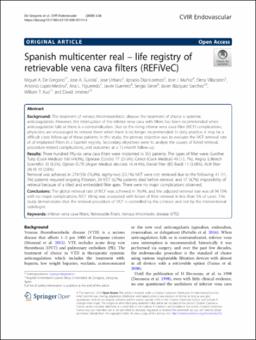| dc.description.abstract | Abstract
Background: The treatment of venous thromboembolic disease the treatment of choice is systemic anticoagulation. However, the interruption of the inferior vena cava with filters has been recommended when anticoagulation fails or there is a contraindication. Due to the rising inferior vena cava filter (IVCF) complications, physicians are encouraged to retrieve them when there is no longer recommended. In daily practice, it may be a difficult close follow-up of these patients. In this study, the primary objective was to evaluate the IVCF retrieval rate of all implanted filters in a Spanish registry. Secondary objectives were to analyze the causes of failed retrieval, procedure-related complications, and outcomes at a 12-month follow-up.
Results: Three hundred fifty-six vena cava filters were implanted in 355 patients. The types of filter were: Gunther Tulip (Cook Medical) 160 (44.9%), Optease (Cordis) 77 (21.6%), Celect (Cook Medical) 49 (13, 7%), Aegisy (Lifetech Scientific) 33 (9.2%), Option ELITE (Argon Medical devices) 16 (4.4%), Denali filter (BD Bard) 11 (3.08%), ALN filter (ALN) 10 (2.8%). Removal was achieved in 274/356 (76,9%). eighty-two (23,1%) IVCF were not retrieved due to the following: 41 (11,5%) patients required ongoing filtration, 24 IVCF (6,7%) patients died before retrieval, and 17 (4,7%) impossibility of retrieval because of a tilted and embedded filter apex. There were no major complications observed.
Conclusions: The global retrieval rate of IVCF was achieved in 76.9%, and the adjusted retrieval rate was of 94.15% with no major complications. IVCF tilting was associated with failure of filter removal in less than 5% of cases. This study demonstrates that the retrieval procedure of IVCF is controlled by the clinician and not by the interventional radiologist.
Keywords: Inferior vena cava filters; Retrievable filters; Venous thrombotic disease (VTD).
PubMed Disclaimer | es |


